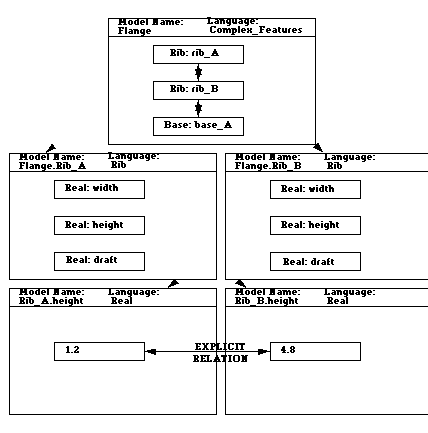6.3 MODEL STATICS
6.3.4 SEMANTICS
At this point in the example of the English modeling language, Chomsky's sentence, "Colourless green ideas sleep furiously" is a perfectly reasonable model [Bartlett 80]. But this sentence highlights the incompleteness of the syntactic model. A further iteration of the language is needed to deal with semantics - to prevent syntactically valid, yet meaningless models from being accepted.
The syntactic model can be visualized as structuring morphological elements on a single plane. Semantics, dealing with the meaning of the object, can be considered as orthogonal to the syntactic plane. A semantic model, for purposes here, must deal with both the contents of each morphological object and the relation of the contents of one object to the contents of another. Whereas the syntactic space limited the number of configurations with a modeling language, the semantic space must deal with more than one language. In effect, the semantic space must transcend the dimensions of a single model.
The semantic modeling language L''' adds constraints or rules on content. Whereas the previous languages defined a dimension carved out of a static, universal space, the semantic language L''' must incorporate entities from another dimension; another modeling language. The contents of a given object do not necessarily reside in the same topological domain of the syntactic models.
Figure 74 illustrates the modeling of the complex feature known as a flange. A flange is the combination of one rib on top of another rib. The syntactical combination of ribs and the part base is indicated by the top model of this figure.
The two rib objects in the top model stand for two rib models as well, and these are depicted as the two center models rib_A and rib_B. The models in turn contain property models of width, height, and draft. These property models are of type "real" and stand for actual values.
To define a complex feature in terms of geometric relations requires working with at least three modeling languages. Let it be assumed that accessing an object on one syntactic plane leads to another syntactic plane. Then the same mechanisms can be used throughout all modeling layers until some non-decomposable value such as a number or text is reached. Difficulty is encountered when elements on one plane must be compared to elements from another.
There are a number of ways to specify the inter-relation of elements within these disparate models. One way is directly analogous to that of Figure 74. Given a large, parent window underlying the model windows show, links are drawn directly between individual elements. Another way is to copy the elements and paste them in some other model, where relationships can be specified. This model would either have to be type-less or very broadly defined to allow elements from a number of different models.
Figure 74 Syntactic and Semantic Modeling of a Complex Feature
